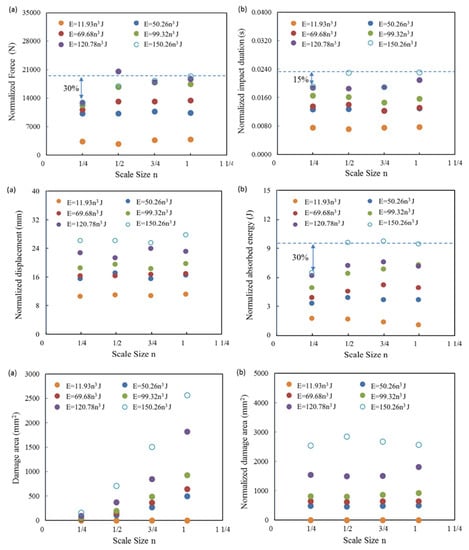Scale Effect on Impact Performance of Unidirectional Glass Fiber Reinforced Epoxy Composite Laminates
Abstract
:1. Introduction
2. Scaling Theory
3. Materials and Methods
3.1. Materials and Fabrication
3.2. Low-Velocity Impact Test
4. Results
4.1. Scale Effect on Impact Force and Duration
4.2. Scale Effect on Impact Displacement
4.3. Scale Effect on Damage Modes and Damage Area
5. Discussion
6. Conclusions
Author Contributions
Funding
Acknowledgments
Conflicts of Interest
References
- Jones, N. Structural Impact; Cambridge University Press: Cambridge, UK, 1989. [Google Scholar]
- Shah, S.Z.H.; Karuppanan, S.; Megat-Yusoff, P.S.M.; Sajid, Z. Impact resistance and damage tolerance of fiber reinforced composites: A review. Compos. Struct. 2019, 217, 100–121. [Google Scholar] [CrossRef]
- Yang, F.J.; Cantwell, W.J. Impact damage initiation in composite materials. Compos. Sci. Technol. 2010, 70, 336–342. [Google Scholar]
- Morton, J. Scaling of Impact-Loaded Carbon-Fibre Composites. AIAA 1988, 26, 989–994. [Google Scholar] [CrossRef]
- Jones, N. Scaling of Inelastic Structures Loaded Dynamically. In Structural Impact and Crashworthiness; Davies, G.A.O., Ed.; Elsevier Appl. Sci.: London, UK; New York, NY, USA, 1984; Volume 1, pp. 45–74. [Google Scholar]
- Duffey, T.A.; Cheresh, M.C.; Sutherland, S.H. Experimental Verification of Scaling Laws for Punch-impact-loaded Structures. Int. J. Impact Eng. 1984, 2, 103–117. [Google Scholar] [CrossRef]
- Leonetti, L.; Fantuzzi, N.; Trovalusci, P.; Tornabene, F. Scale Effects in Orthotropic Composite Assemblies as Micropolar Continua: A Comparison betweenWeakand Strong-Form Finite Element Solutions. Materials 2019, 12, 758. [Google Scholar] [CrossRef]
- Sutherland, L.S.; Shenoi, R.; Lewis, S.M. Size and Scale Effects in Composites: Literature Review. Compos. Sci. Technol. 1999, 59, 209–220. [Google Scholar] [CrossRef]
- Johnson, D.P.; Morton, J.; Kellas, S.; Jackson, K. Size Effects in Scaled Fibre Composites under Four-pont Flexure Loading. AIAA 2000, 38, 1047–1054. [Google Scholar] [CrossRef]
- Jackson, K.E. Scaling Effects in the Flexural Response and Failure of Composite Beams. AIAA 1992, 32, 2099–2105. [Google Scholar] [CrossRef]
- Soutis, C.; Lee, J.; Kond, C. Size Effects on Compressive Strength of T300/924C Carbon Fibre-Epoxy Laminates. Plast Rubber Compos. 2002, 31, 364–370. [Google Scholar] [CrossRef]
- Martin-Barrera, C.; Gonzalez-Chi, P.I. Scaling effects on the mechanical performance of symmetrical and balanced thermoplastic laminates. Polym. Test 2012, 31, 1053–1061. [Google Scholar] [CrossRef]
- Zhou, J.; Guan, Z.; Cantwell, W.J. Scaling Effects in the Mechanical Response of Sandwich Structures Based on Corrugated Composite Cores. Compos. Part B Eng. 2016, 94, 88–96. [Google Scholar] [CrossRef]
- Mena-Tun, J.L.; Martin-Barrera, C.; Gonzalez-Chi, P.I. Scaling effect on the tensile properties of [±45/0/±45/0/±45] Polypropylene/Twaron laminates. Polym. Test 2015, 43, 49–57. [Google Scholar] [CrossRef]
- Liu, D.; Raju, B. Size Effect on Impact Response of Composite Laminates. Int. J. Impact Eng. 1998, 21, 837–854. [Google Scholar] [CrossRef]
- Swanson, S.R. Scaling of Impact Damage in Fibre Composites from Laboratory Specimens to Structures. Compos. Struct. 1993, 25, 249–255. [Google Scholar] [CrossRef]
- Sutherland, L.S.; Soares, C.G. Scaling of Impact on Low Fibre-volume Glass-polyester Lminates. Compos. Part A Appl. S 2007, 38, 307–317. [Google Scholar] [CrossRef]
- Viot, P.; Ludovic, B.; Guillaumat, L.; Lataillade, J.L. Scale effects on the response of composite structures under impact loading. Eng. Fract Mech. 2008, 75, 2725–2736. [Google Scholar] [CrossRef] [Green Version]
- Oshiro, R.E.; Alves, M. Scaling Impacted Structures. Arch. Appl. Mech. 2004, 74, 130–145. [Google Scholar]
- Yang, F.J.; Hassan, M.Z.; Cantwell, W.J.; Jones, N. Scaling effects in the low velocity impact response of sandwich structures. Compos. Struct. 2013, 99, 97–104. [Google Scholar] [CrossRef]
- Wagih, A.; Maimí, P.; Blanco, N.; Costa, J. A quasi-static indentation test to elucidate the sequence of damage events in low velocity impacts on composite laminates. Compos. Part A Appl. Sci. Manuf. 2016, 82, 180–189. [Google Scholar] [CrossRef]
- Sutherland, L.S.; Guedes Soares, C. The use of quasi-static testing to obtain the low-velocity impact damage resistance of marine GRP laminates. Compos. Part B Eng. 2012, 43, 1459–1467. [Google Scholar] [CrossRef]
- Bogenfeld, R.; Kreikemeier, J.; Wille, T. An analytical scaling approach for low-velocity impact on composite structures. Compos. Struct. 2018, 187, 71–84. [Google Scholar] [CrossRef]
- Bogenfeld, R.; Kreikemeier, J.; Wille, T. Validation of the low-velocity impact damage prediction through analytical scaling. Compos. Struct. 2019, 209, 715–726. [Google Scholar] [CrossRef]
- Abisset, E.; Daghia, F.; Sun, X.C.; Wisnom, M.R.; Hallett, S.R. Interaction of inter- and intralaminar damage in scaled quasi-static indentation tests: Part 1—Experiments. Compos. Struct. 2016, 136, 712–726. [Google Scholar] [CrossRef]
- Wagih, A.; Maimí, P.; Blanco, N.; González, E.V. Scaling effects of composite laminates under out-of-plane loading. Compos. Part A Appl. S 2019, 116, 1–12. [Google Scholar] [CrossRef]
- Shen, Y.O.; Jiang, B.; Li, Y. Low velocity impact response and energy absorption behavior on glass fibre reinforced epoxy composites. Sci. China Technol. Sci. 2017, 60, 1339–1346. [Google Scholar] [CrossRef]
- Shivakumar, K.N.; Elber, W. Prediction of impact force and duration due to low-velocity impact on circular composite laminates. J. Appl. Mech. 1985, 52, 674–680. [Google Scholar] [CrossRef]
- Hitchen, S.; Kemp, S. The effect of stacking sequence on impact damage in a carbon fibre epoxy composite. Composites 1995, 26, 207–214. [Google Scholar] [CrossRef]




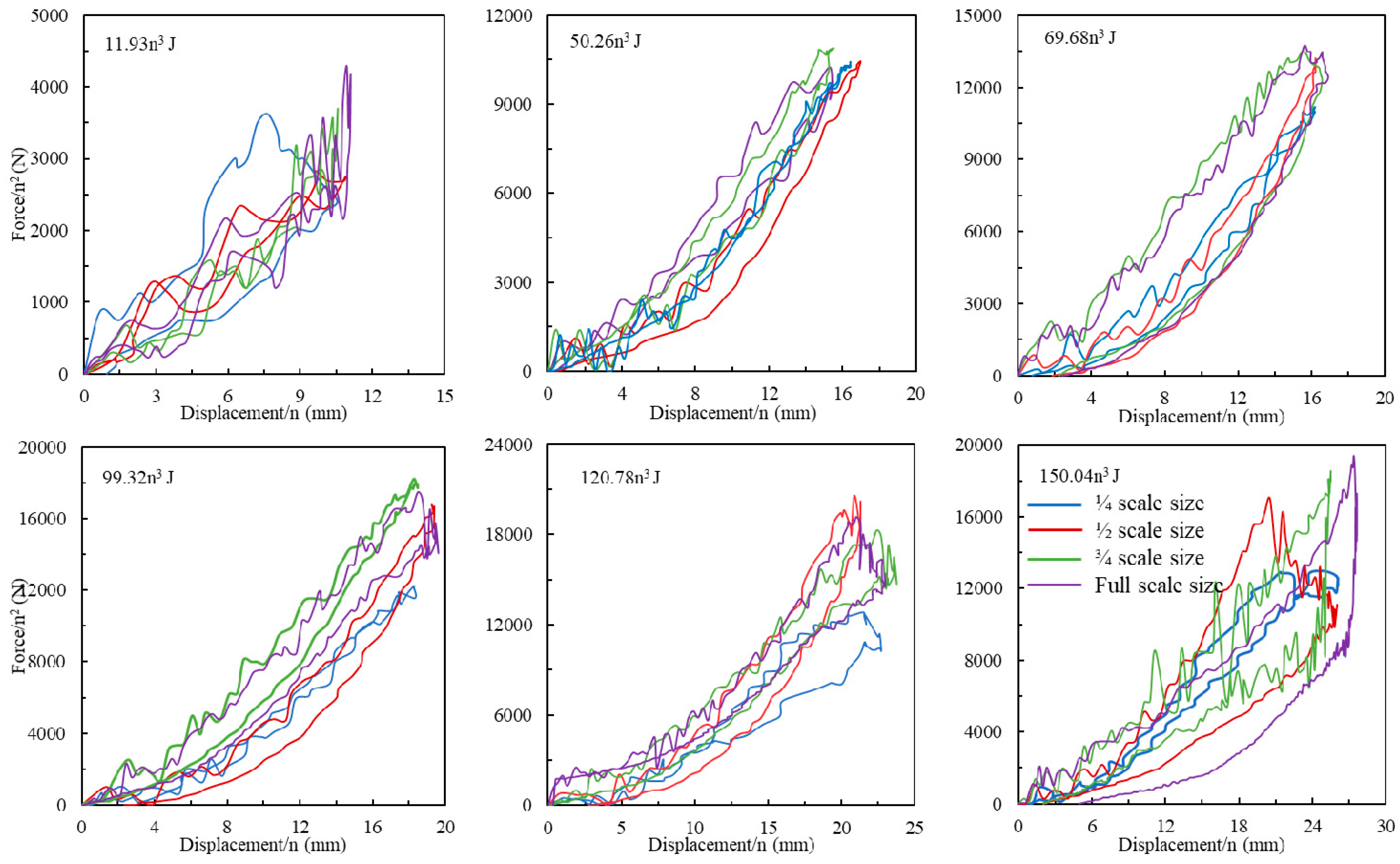
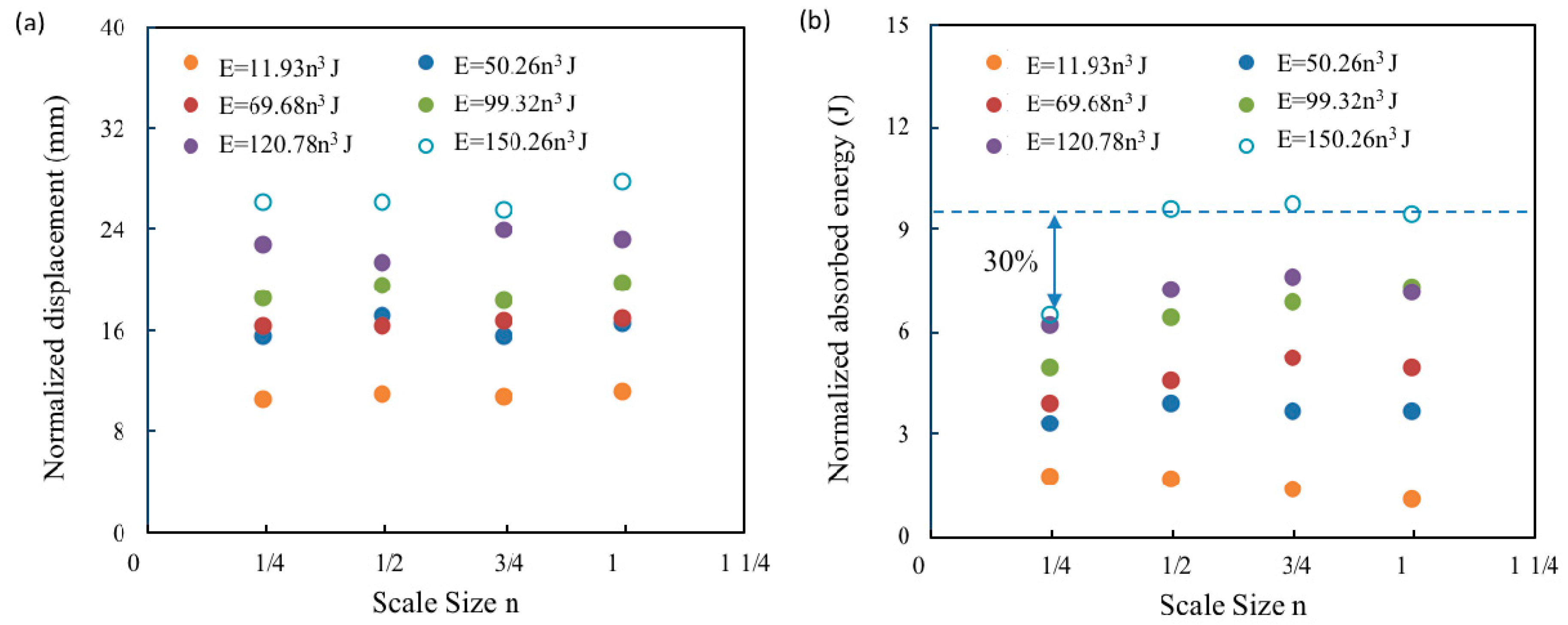

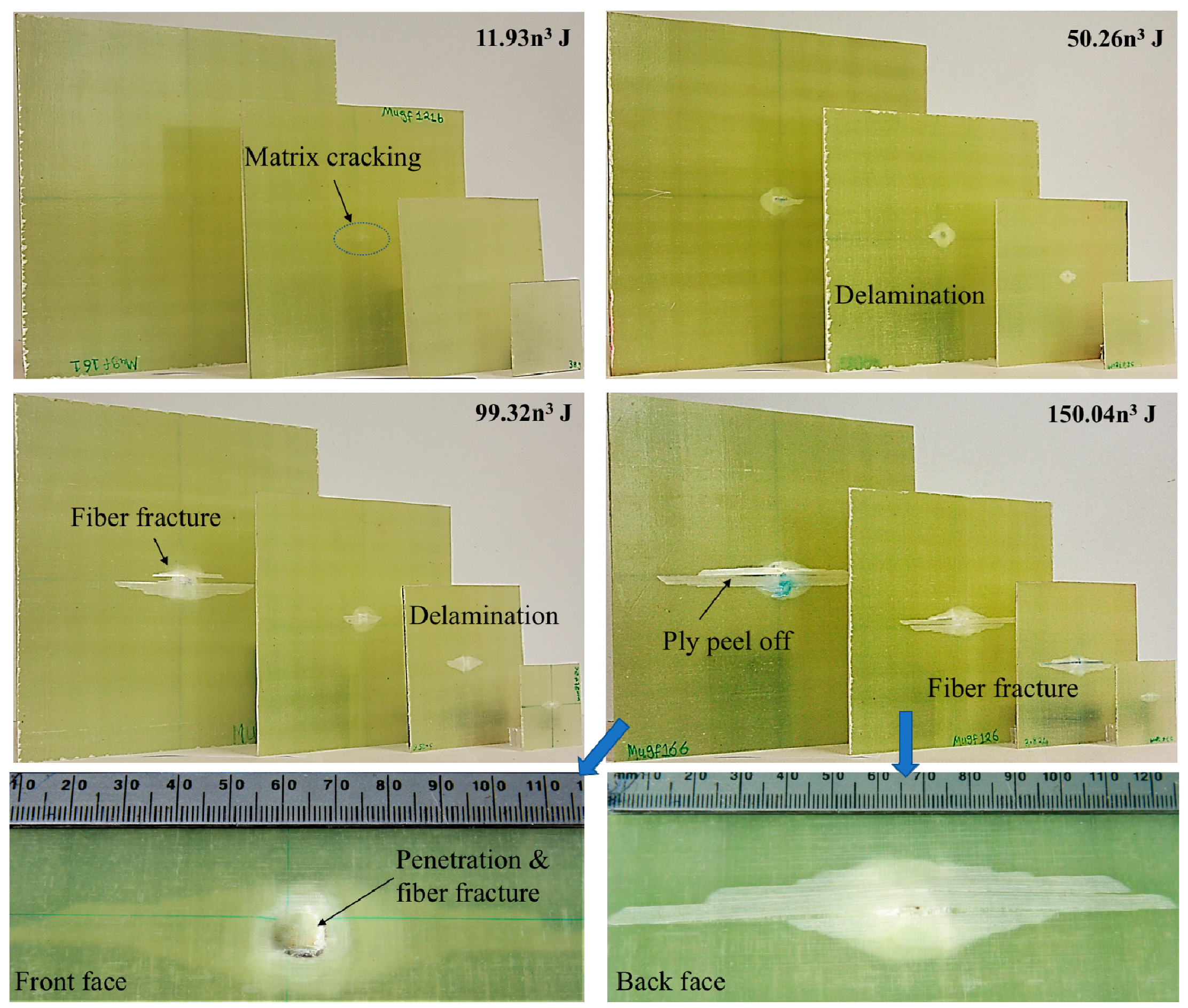
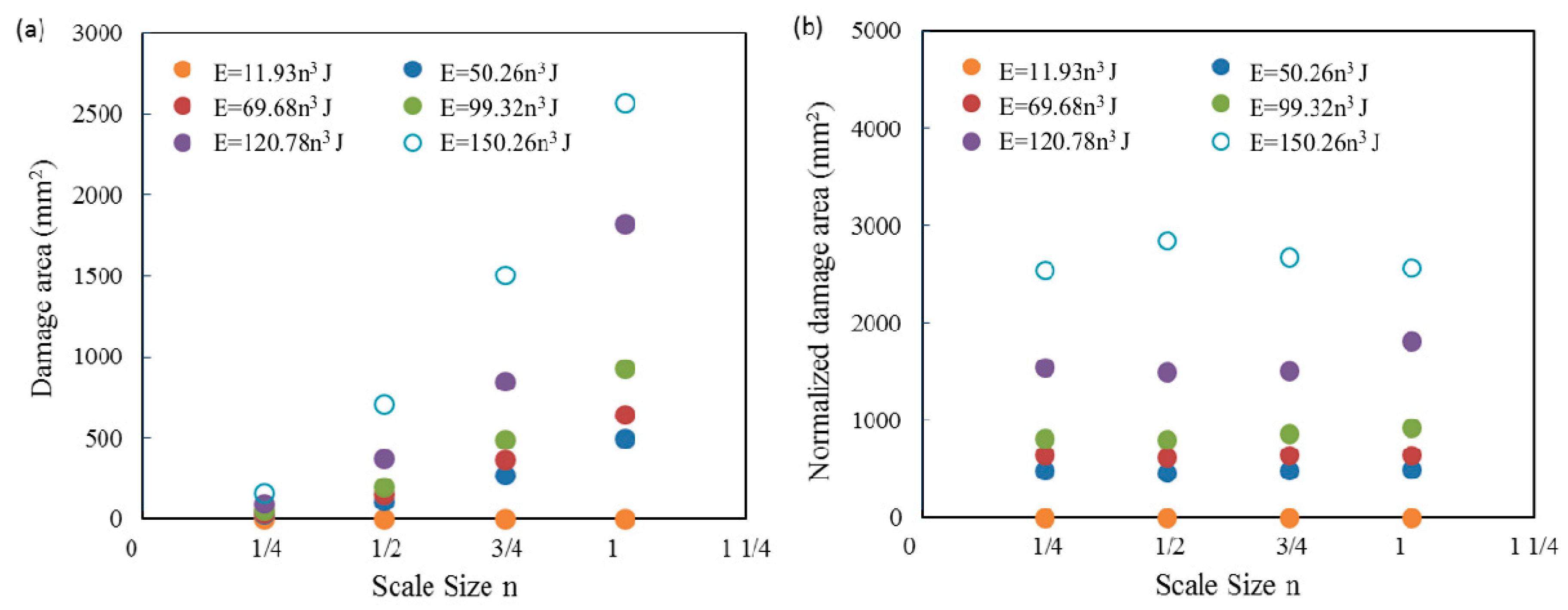
| Symbol | Parameter | Dimension | Scale Factor |
|---|---|---|---|
| h | Specimen Thickness | L | n |
| R | Specimen Radius | L | n |
| ρ | Specimen Density | M L−3 | 1 |
| υ | Specimen Poisson’s Ratio | - | 1 |
| E | Specimen Modulus | M T−2 L−1 | 1 |
| mi | Impactor Mass | M | n3 |
| Vi | Impactor Velocity | L T−1 | 1 |
| ρi | Impactor Density | M L−1 | 1 |
| υi | Impactor Poisson’s Ratio | - | 1 |
| Ei | Impactor Modulus | M T−2 L−1 | 1 |
| t | Impact Time | T | n |
| δ | Impact Deflection | L | n |
| P | Impact Force | M T−2 L | n2 |
| Scale Factor λ | Edge Length (mm) | Avg. Thick (mm) | No. of Plies | Impact Height (mm) | Indenter Diameter (mm) | Support Diameter (mm) |
|---|---|---|---|---|---|---|
| ¼ | 65 | 0.95 | 4 | 500 | 5 | 50 |
| ½ | 130 | 1.95 | 8 | 500 | 10 | 100 |
| ¾ | 195 | 3.0 | 12 | 500 | 15 | 150 |
| 1 | 260 | 4.0 | 16 | 500 | 20 | 200 |
| Scale Size | 11.93n3 J | 50.26n3 J | 69.68n3 J | 99.32n3 J | 120.78n3 J | 150.04n3 J | ||||||
|---|---|---|---|---|---|---|---|---|---|---|---|---|
| mi (kg) | W (J) | mi (kg) | W (J) | mi (kg) | W (J) | mi (kg) | W (J) | mi (kg) | W (J) | mi (kg) | W (J) | |
| ¼ | 0.04 | 0.19 | 0.16 | 0.79 | 0.22 | 1.09 | 0.32 | 1.56 | 0.39 | 1.896 | 0.48 | 2.34 |
| ½ | 0.31 | 1.5 | 1.28 | 6.26 | 1.79 | 8.76 | 2.55 | 12.5 | 3.07 | 15.07 | 3.82 | 18.76 |
| ¾ | 1.03 | 5.03 | 4.30 | 21.09 | 6.02 | 29.55 | 8.57 | 42.05 | 10.38 | 50.91 | 12.91 | 63.32 |
| 1 | 2.43 | 11.93 | 10.25 | 50.26 | 14.21 | 69.68 | 20.25 | 99.32 | 24.62 | 120.78 | 30.59 | 150.04 |
| Scale Size | 1/4 | 1/2 | 3/4 | 1 |
|---|---|---|---|---|
| Kb | 7.04 × 104 | 1.41 × 105 | 2.29 × 105 | 3.05 × 105 |
| Ks | 3.26 × 107 | 2.76 × 107 | 4.24 × 107 | 5.64 × 107 |
| Kb/s | 7.02 × 104 | 1.41 × 105 | 2.28 × 105 | 3.03 × 105 |
| Km | 2.12 × 1010 | 1.01 × 1010 | 6.92 × 109 | 5.19 × 109 |
© 2019 by the authors. Licensee MDPI, Basel, Switzerland. This article is an open access article distributed under the terms and conditions of the Creative Commons Attribution (CC BY) license (http://creativecommons.org/licenses/by/4.0/).
Share and Cite
Shen, Y.; Jiang, B.; Li, Y. Scale Effect on Impact Performance of Unidirectional Glass Fiber Reinforced Epoxy Composite Laminates. Materials 2019, 12, 1319. https://doi.org/10.3390/ma12081319
Shen Y, Jiang B, Li Y. Scale Effect on Impact Performance of Unidirectional Glass Fiber Reinforced Epoxy Composite Laminates. Materials. 2019; 12(8):1319. https://doi.org/10.3390/ma12081319
Chicago/Turabian StyleShen, Yiou, Bing Jiang, and Yan Li. 2019. "Scale Effect on Impact Performance of Unidirectional Glass Fiber Reinforced Epoxy Composite Laminates" Materials 12, no. 8: 1319. https://doi.org/10.3390/ma12081319




